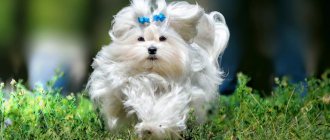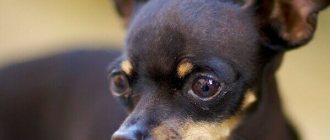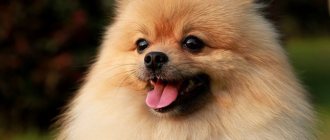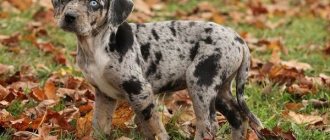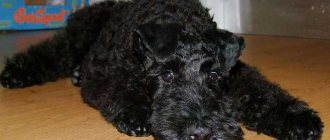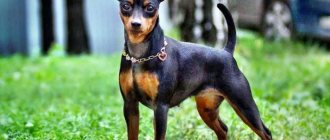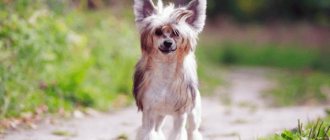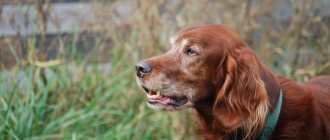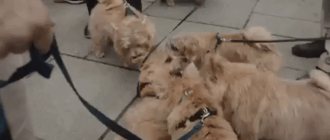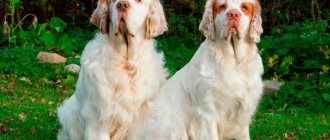The Newfoundland is a unique dog, which is also called a diver. Her impressive size and menacing appearance do not at all combine with her surprisingly good-natured character. These dogs have no aggression towards any living beings at all; they love to serve people and help those who are weaker. Because of this, the Newfoundland will not become a watchman or guard; it simply cannot bite a person. He is good-natured, sociable, obedient, affectionate and loyal. But before getting a dog of this breed, you need to study its description, pros and cons, and reviews from owners.
- Head
- Education and training
- Content Features
History of the Newfoundland breed
Newfoundland
The homeland of the breed, which shares its name, is the island of Newfoundland, located off the east coast of North America and belonging to Canada. There are many legends about the origin of these dogs, and many of them, quite possibly, are not so far from the truth.
Some cynologists suggest that the ancestors of Newfoundlands are Berenbeitzers, bear-fighting dogs common in medieval Europe, which are also considered the ancestors of mastiffs. These powerful dogs allegedly arrived on the island with a Viking crew led by the Scandinavian navigator Leif Eriksson on a ship that arrived off the coast of Newfoundland around the year 1000. Subsequently, the descendants of these animals went wild. When Europeans appeared here again in the 16th century, they were amazed at the sight of the huge black and shaggy dogs they met here.
According to the famous Swiss cynologist, Professor Albert Heim, who specialized in the study of Newfoundlands, these animals descended from Molossians, massive mastiff-like dogs of the so-called mastiff type, brought to the island by the British during the period of its colonization.
There is an opinion that among the ancestors of Newfoundlands are large black and piebald shepherd dogs, which also came overseas from the European continent. White Pyrenean mountain dogs are also mentioned, which could have been brought to North America by Spanish and Portuguese settlers. It is believed that it was thanks to them that the black and white color of Newfoundlands arose.
Some dog experts suggest that the formation of the breed could not have happened without the aboriginal representatives of the dog tribe. Presumably, already in the 11th century, indigenous tribes lived on the island, descendants of the Paleo-Eskimo peoples, whose companions and assistants were sled dogs. Perhaps it was from them that Newfoundlands inherited their friendly disposition and determination to come to a person’s aid under any circumstances.
The first descriptions of dogs from the island of Newfoundland began to appear at the dawn of the 18th century. There were two known types: the "Little Dog of St. John" and the "Big Dog of St. John." “Saint John” or “St. John’s” is the name of the largest settlement on the island at that time, today it is the main city of the Canadian province of Newfoundland. The descriptions noted the excellent working qualities of these dogs, their good-natured character, as well as the ability to dive deep and swim far. The British began to export dogs from the island and soon began their systematic selection. The first type was used in the development of the retriever breed, and the second became known as the Newfoundland. According to some sources, for the first time, in 1775, George Cartwright named his dog a Newfoundland.
Newfoundland puppy
Initially, English breeders selected black and white dogs for breeding, later named Landseers in honor of the British painter Edwin Henry Landseer. He loved to depict such dogs on his canvases. However, over time, breeders began to give preference to animals with a solid black color.
In the middle of the 19th century, a fashion arose in Great Britain for large representatives of the dog breed. At exhibitions in 1860 and 1862, held in Birmingham, dogs from the island of Newfoundland made a splash, and in 1864, a dog belonging to the Prince of Wales himself took first place at the Birmingham Exhibition. In 1878, the first Newfoundland was entered into the stud book of the English Kennel Club, the oldest kennel club in the world, and a year later a breed standard was developed. The magnificent, powerful dogs began to rapidly gain popularity in Europe, and in 1885 the first Newfoundland fan club was founded in the USA. Today, in famous kennel clubs in Europe and the USA you can buy Newfoundland puppies, whose official pedigree dates back to the 80s of the last century.
At the beginning of the 20th century, Newfoundlands gained popularity among Russian aristocrats, but fashion for them did not become widespread. In the 40-50s, representatives of this breed were actively exported to the USSR from Germany. At the Ministry of Defense nursery “Red Star”, breeders worked to improve the working qualities of Newfoundlands. They were crossed with German and Caucasian shepherds, trying to give the dogs aggressiveness and at the same time preserve their rescuer instincts. These experiments ended in failure, since the dogs, instead of helping the person, showed aggression towards him. Newfoundlands also did not succeed in guard duty. In the 80s, breeding work to develop a new breed was stopped, although it managed to get its own name - Moscow diver.
Since the mid-80s, breeding of imported Newfoundlands began in Russia, and Moscow divers gradually “dissolved” in their population. Their memory is preserved by the pedigrees of a small number of domestic Newfoundlands and the tradition of calling this breed of dog divers. Newfoundlands are often also called Newfies.
Interesting Facts
One of the most important facts about the breed: Newfoundlands are good-natured people, aggression is unknown to them.
The second point is the love of water; representatives of the breed love to swim.
In third place is the independence of these dogs. They are used as rescuers, which requires making quick and correct decisions. Not every person has this ability, but Newfoundlands have it.
On the fourth line is a tendency to various diseases. The Newfoundland dog, mistakenly called the diver, is quite sickly.
Speaking about divers, it is worth noting that the breed was bred in the Soviet Union (Krasnaya Zvezda nursery). Obtained as a result of crossing a Newfoundland with a Caucasian Shepherd, Rottweiler, Giant Schnauzer, and Great Dane. Currently, this breed does not exist; it differed from the Newfoundland both in appearance and in character.
The Newfoundland's lifespan is extremely short, with many members of the breed only surviving to 8-9 years of age. Occasionally you can find a dog whose lifespan is 11 years.
Newfoundland appearance
Brown Newfoundland
The Newfoundland is a powerful, athletic dog whose coat resembles a luxurious boyar's fur coat. The huge size of the dog does not make it clumsy and clumsy. On the contrary, they have excellent control of their own body and look quite graceful. Males can weigh up to 70 kg, females - up to 55 kg.
Frame
The Newfoundland's body is strong, dense, and compact. The length of the body from the withers to the base of the tail is identical to the length from the withers to the floor. The back and croup are wide, solid, the loin is strong, muscular, the chest is powerful. The lower line of the chest and abdomen is almost flat. Bitches' bodies are often more elongated and not as massive as those of males.
Head
Large, heavy, with a wide skull with a slightly protruding arch. The occipital protuberance is well developed. The stop is discernible, but it is not overly sharp. The Newfoundland's relatively short muzzle is square in shape and covered with short, soft fur. There are no skin folds on the muzzle. The corners of the mouth are clearly expressed. Cheeks are soft. The nostrils are well developed. The color of the nose is distinct. In black and white and black dogs it is black, and in brown dogs it is brown.
Jaws and teeth
The jaws are powerful. The teeth look impressive: they are large, white, with pronounced fangs. Scissor bite or straight bite.
Eyes
Newfoundland muzzle
Small, set deep and at a fairly wide distance from each other. The eyelids should not droop and expose the reddish conjunctiva. Black and black and white Newfoundlands should have dark brown eyes; brown animals may have a lighter tint.
Ears
The Newfoundland's ears are small, set closer to the back of the head, triangular in shape, and rounded at the tips. If an adult Newfoundland's ear is pulled forward, its end should reach the inner corner of the eye, which is located on the same side of the head.
Neck
Powerful, muscular, without obvious dewlap. It is long enough to provide a majestic head position.
Limbs
The Newfoundland's forelimbs should be straight. They remain parallel even in cases where the dog walks measuredly or moves at a leisurely trot. The shoulder muscle system is well developed, the shoulders themselves are set back. Pasterns slightly sloping. The hind limbs are impressively powerful, with well-developed thigh muscles. The lower legs are strong and elongated. The hind pasterns are short, set low and wide, they are parallel to each other, and do not protrude either in or out. The Newfoundland's feet are large and proportionate to the body. They are round and look bunched together. The fingers are hard, compact, tightly closed, they are connected by swimming membranes. The claws of black and black-and-white divers are black; brown dogs have horn-colored claws. If the dog has dewclaws, they should be removed.
Tail
Newfoundland is a big swimmer
The Newfoundland's tail is thick and wide at the base. When a dog swims, it acts like a rudder. In a standing animal, the tail is slightly lowered, a slight bend is noticeable at its end, it descends approximately to the hock joint, sometimes a little lower. When the animal is in motion or in a playful mood, the tail is held high, then it is slightly curved upward. It is not allowed for the tail to be thrown over the back or tucked between the legs.
Movement
The Newfoundland moves with sweeping movements, demonstrating tirelessness and power. The back remains straight during movement. While running, as the dog increases speed, it tries to place its paws closer to the midline.
Wool
Newfoundland puppy black and white
Both the coat and the undercoat of the Newfoundland are oily, waterproof, smooth, thick, and have a rigid structure. Wool has a water-repellent effect. The guard hairs are quite long and straight, there are no curls, but slight waviness is acceptable. The soft, dense undercoat becomes even thicker in winter, especially in the croup and chest area. The dog's tail is covered with long, thick hair; its head, muzzle and ears are covered with short, soft hair. The limbs are decorated with fringes.
Color
The classic color is black. It is desirable that the color be as intense as possible; when fading in the sun, a brownish tint is acceptable. For the brown color of the Newfoundland, shades are allowed: from chocolate to bronze. With these two monochrome colors, white markings on the chest, toes, and tip of the tail are acceptable.
For the black and white color, the most preferable option is the following: a black head with a white blaze that goes down to the muzzle, black spots on the saddle, in the area of the croup and the base of the tail. The dominant cover should be white.
Flaws
- Lightweight body with light bones, giving the impression of looseness.
- Hunched, soft or sagging back.
- Pointed or simply elongated muzzle.
- Round or protruding eyes, yellow in color, exposed conjunctiva.
- High limbs. Weak pasterns, splayed paws on the front limbs, straightened knee angles and turned inward paws on the hind limbs. Absence of membranes connecting the fingers.
- An excessively short or elongated tail, or a broken tail that curls at the end.
- Mincing, shuffling or unsteady gait, sideways movements, short strides, crossing the forelimbs during movement.
Newfoundland photo
Newfoundland character
Newfoundland with a
Newfoundland child is called a dog with a “golden” character. He is kind, loyal, friendly, tactful, and is not at all inclined to aggression. Using the terminology of psychics, we can say that he has a good biofield. The very presence of this good-natured giant in the house creates an atmosphere of comfort, safety and benevolence.
Perhaps Newfoundlands are the most socialized dogs in the world; the main purpose of their existence is to serve humans. They are selflessly heroic and ready to help at any moment. They are completely devoted to the work assigned to them - be it a police or military mission, accompanying the blind, or even transporting goods. It is not for nothing that one of the canvases by the British artist Edwin Henry Landseer, which depicts the Newfoundland in all its glory, is called “A Worthy Member of Human Society.”
Divers demonstrate their excellent character traits from early childhood. The kids are not at all capricious, they quickly become attached to the owner, but they do not get bored, demanding increased attention, and do not whine or bark for no reason.
Adult dogs are incredibly smart and practical. You could even say that they have an analytical mind and have their own opinion on any issue. They can simply ignore commands that seem meaningless to them or execute them in their own way. But in order to rush to the aid of a drowning person, this dog does not need a command at all - it will selflessly rush into the water in any case. Newfoundlands act clearly and confidently in dangerous situations; for this they also do not need special instructions. Actually, innate intelligence and the ability to independently and quickly make the right decision under the circumstances is a distinctive feature of the outstanding intelligence of these animals.
Newfoundland with a cat
Newfoundlands are well versed in the intonations of the human voice and can easily determine what mood the owner is in. They understand when they need to provide support by being nearby, or they move out of sight. Very polite by nature, Newfoundlands are very sensitive to rudeness towards themselves. The dog, like a person, is offended when they shout at him, and after a quarrel he withdraws into himself for a while, refusing to communicate with the offender.
Newfoundlands are not the best watchdogs, since they initially treat all people kindly and are open to communication. You should not expect an instant aggressive reaction to a stranger from them, since these dogs are not prone to sudden and rash actions, and they need some time to analyze the situation. Sensing danger, they first warn the enemy with a menacing bark, and then fiercely attack him with all their remarkable power.
Newfoundlands love family picnics. Inside the car, they behave sedately and do not worry. Playing in nature, especially near bodies of water where they can swim to their heart's content, brings incredible pleasure to these dogs. Parents can rest assured about their children if they have a vigilant Newfoundland next to them. He will gladly take part in children's amusements, but will stop risky pranks - on his own or with a loud bark he will notify others of the danger.
Newfoundland is a one-woman dog. Having given his heart to one family, he will forever remain faithful to it. Having changed owners for some reason, the dog will be polite to them, but will not be able to get rid of homesickness. It will be difficult for new owners to establish a trusting relationship with such a pet.
With beloved owner
And the mistress
Application
Newfies are born rescuers, they swim well, pulling the victim to the shore, they are not afraid to jump into the water from a boat, or swim to a drowning person with a life preserver.
Strong dogs, they can easily tow a boat; in the north they are actively used for transporting heavy loads on sleds.
But still, their main purpose is to be a companion dog, a friend for the whole family.
The Newfoundland is, first of all, a rescue dog, accustomed to making decisions and acting independently in critical situations.
Education and training
Obedient Newfoundland
The Newfoundland's intelligence and excellent memory make ordinary training an enjoyable pastime. The dog grasps everything on the fly and often, without listening to the end of the task, begins to complete it. Commands to this dog should be given in a calm tone, without raising your voice. She simply will not respond to demanding orders and shouts. Actually, this is not required: it is enough for a Newfoundland to ask for anything politely and gently, and he will readily respond to any wish.
Mating
- Newfoundlands are very large dogs, so there should be plenty of space for them to mate . Dogs must be brought together in the dog's territory. The first time should be carried out under the guidance of a specialist.
- Puberty comes to dogs at the age of 8-10 months, but they can only be bred at 20, when the bitch has her 3rd heat , otherwise she will not be able to bear healthy offspring. Signs that a girl is ready: light discharge, a swollen loop, playful behavior.
- Both dogs need to be examined for pathologies and diseases. It is also necessary to remove worms and external parasites two weeks before mating.
- Sexual intercourse can last 10-15 minutes, and the lock 20-30. The girl must be supported under her stomach and not allowed to sit down. The dog is sent into the loop. In the castle, the dogs are restrained, but in such a way as not to injure the genitals. Mating is repeated after 2 days.
Care and maintenance
Newfoundlands feel great both in nature and in urban environments: they are not afraid of either busy streets or traffic. Small-sized apartments are not the best place to live for these giants, but medium-sized housing is quite suitable for them, because dogs with a calm disposition do not have the habit of rushing around the apartment, sweeping away everything around them. A Newfoundland should have its own place in the house where it can sleep or just relax. It is desirable that it be spacious and have an orthopedic base, for example, it could be a small mattress. It should be covered with a cloth that can be easily washed, as these dogs salivate profusely.
Newfoundlands are not known for their playfulness and tend to spend their time passively, but they need physical exercise. These dogs should be walked at least twice a day, preferably in the morning and evening.
The ideal place to keep a Newfoundland is a country house, near which there is a pond, lake or river. Keeping an enclosure is not suitable for a diver - deprived of communication with people, he will be sad. Moreover, you can’t put him on a chain.
Newfoundland wool requires systematic care
The Newfoundland's thick coat requires systematic care. You should brush your dog at least three times a week with a stiff brush, otherwise its fur will mat and form tangles that can make your dog’s life miserable by causing itching. If a tangle has already formed, it is better to untangle it. They are cut out in extreme, completely neglected cases. Twice a year, in autumn and spring, Newfoundlands' undercoat is renewed. During this period, the dog needs to be brushed every day. To help your pet, you can also contact a groomer who will give you an easier haircut.
Newfoundlands do not require frequent baths because their coat, impregnated with natural lubricants, repels dirt and water. The use of shampoos has a very bad effect on the condition of the coat.
Newfoundland's nails need to be trimmed once a month. It is necessary to monitor the ears and eyes, systematically checking them for the presence of discharge that may indicate infectious diseases. Periodically, ears and eyes should be wiped with a damp cloth.
Feeding Newfoundlands should be taken seriously. It should be balanced, plentiful, but in moderation, since these dogs are prone to obesity.
When feeding naturally, the dog’s diet should contain the following products:
Ooh, that's bacon
- veal, beef, lamb, rabbit (50% of the total number of products). It is not recommended to feed them pork and poultry meat;
- from cereals - rolled oats and buckwheat, and it is better to exclude rice, pearl barley, millet;
- sea fish - raw or boiled, river fish - exclusively boiled;
- cottage cheese;
- carrots, in small quantities – beets and cabbage, scalded parsley, nettle, dill, lettuce;
- bread in the form of crackers.
Potatoes, spicy and smoked foods, sweets, especially chocolate, are prohibited in the food.
The Newfoundland diet can include ready-made, high-quality super-premium and holistic food.
Puppies should be fed 5 times a day; as they get older, the number of feedings decreases. For adult dogs, it is enough to give food twice a day.
Who is this little guy here?
Sorry…
A dog that charms
It is simply impossible to pass by a dog whose size resembles a huge bear, and whose habits resemble a little naughty one.
Playful, kind, loyal and brave, that’s all he is, the hero of today’s article.
Thanks to their expressive appearance and huge, devoted heart, these dogs have become heroes of many literary works, participants in all kinds of expeditions, and even military operations.
Be that as it may, these “bears”, in the literal sense of the word, are inexhaustible sources of kindness, positivity and love.
Reviews about the character of the Newfoundland are the most positive: kind, friendly, non-aggressive, extremely intelligent, easy to train.
Note!
- Nicknames for dogs for boys - easy, rare and most beautiful names for dogs in alphabetical order
Nicknames for girls' dogs - a list of beautiful, funny, unusual nicknames for large and small dog breeds
Maltipoo dog - everything about the dog from A to Z. Photos, description of the breed, character, maintenance features, prices, reviews
However, the health level of such dogs is below average, but the need for care and the cost of maintenance are very high.
Newfoundland Health and Diseases
Newfoundlands are characterized by a number of diseases, both common to all dogs and specific to this breed. Their massiveness creates problems for the musculoskeletal system; they often develop arthritis and hip dysplasia. A sedentary lifestyle and lack of activity can lead to obesity and, as a result, heart disease.
A native of the north, the Newfoundland suffers from the heat and may well suffer from heatstroke. Its main symptoms are lethargy, a dry, warm nose, and lack of appetite. On hot days, you need to make sure that your dog always has water in his bowl. Under no circumstances should you leave your dog in a closed car. In summer, it is advisable to provide the diver with the opportunity to swim more often.
Feeding
The diet needs to be selected from the first days of the puppy’s life in the house. The main thing is to fight excess weight gain. To regularly monitor your pet's weight, you should buy floor scales. By weighing your puppy daily, you can adjust the components of the food to eliminate those that contribute to sudden weight gain.
Experts recommend feeding diver puppies with special food for giant dog breeds. Such industrial feeds include the required amount of vitamins, macro and microelements that growing Newfoundlands need to strengthen skeletal bones and build muscle. Also, the consumption of such food by puppies eliminates diseases such as deformation of the limbs under the weight of the body weight.
It is more advisable to feed adult individuals with natural food. In this case, food for the animals is cooked every day. The food must contain meat (about 40% of the total food). Cereal crops are selected based on the individual characteristics of the animal. If the dog is prone to obesity, then only rice is added to the food. If a dog’s metabolism is too fast, then buckwheat and barley groats (in equal parts) are added to his food. The daily diet must include vegetables - boiled and raw.
Important! These dogs should not be given bones. The powerful jaws of Newfoundlands grind them into small fragments
These fragments, entering the dog’s esophagus, injure it, which is very dangerous for the dogs’ health.
How to choose a puppy
Newfoundland puppies with mother
Newfoundland puppies, of course, need to be purchased from a kennel or from a breeder in whose integrity you are confident. In this case, you will have guarantees that the baby is purebred and has all the necessary vaccinations. At the nursery you will be able to meet his mother, and, if you’re lucky, even his father. This will give you the opportunity to get an idea of what your grown “bear cub” will look like.
According to the rules of the RKF, breeders have the right to sell puppies after they are 45 days old. But many people prefer to buy babies who have already received all vaccinations, that is, at the age of 3-3.5 months. In this case, they can already be walked without fear. Those who want to buy a puppy for breeding should wait until he is 6-9 months old, when the peculiarities of his anatomy and behavior will be obvious.
A small Newfoundland should have a proportionate build and be a tiny replica of an adult dog. A puppy is supposed to be active, curious, and moderately well-fed. His fur should be shiny and clean, without tangles, and his bite should be correct.
Price
There are nurseries for high-breed divers in almost every capital of modern post-Soviet countries. We recommend buying a dog in the capital city of your country.
The price of a Newfoundland in 2022 in Moscow is 35-40 thousand rubles. Puppies from other cities of Russia are cheaper, from 20 to 30 thousand rubles. When calculating your budget, be sure to take into account the possible costs of transporting the animal.
Dogs with champion parents cost from 50 thousand rubles. Yes, that's a lot. But, they are usually purchased for the purpose of further earnings. So keep in mind that buying an expensive purebred diver may be a good investment for you.


